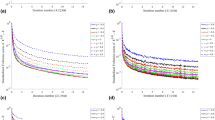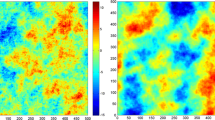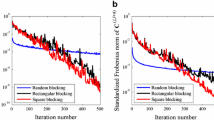Abstract
This paper presents a new approach to the LU decomposition method for the simulation of stationary and ergodic random fields. The approach overcomes the size limitations of LU and is suitable for any size simulation. The proposed approach can facilitate fast updating of generated realizations with new data, when appropriate, without repeating the full simulation process. Based on a novel column partitioning of the L matrix, expressed in terms of successive conditional covariance matrices, the approach presented here demonstrates that LU simulation is equivalent to the “successive” solution of kriging residual estimates plus random terms. Consequently, it can be used for the LU decomposition of matrices of any size. The simulation approach is termed “conditional simulation by successive residuals” as at each step, a small set (group) of random variables is simulated with a LU decomposition of a matrix of updated conditional covariance of residuals. The simulated group is then used to estimate residuals without the need to solve large systems of equations.
Similar content being viewed by others
REFERENCES
Alabert, F., 1987, The practice of fast conditional simulations through the LU decomposition of the covariance matrix: Math. Geol., v. 19, no. 5, p. 368–386.
Davis, M. W., 1987a, Production of conditional simulations via the LU triangular decomposition of the covariance matrix: Math. Geol., v. 19, no. 2, p. 91–98.
Davis, M. W., 1987b, Generating large stochastic simulation-The matrix polynomial approximation method: Math. Geol., v. 19, no. 2, p. 99–107.
Deutsch, C. V., and Journel, A. G., 1998, GSLIB geostatistical software library and user's guide: Oxford University Press, New York, 369 p.
Dietrich, C. R., and Newsam, G. N., 1995, Efficient generation of conditional simulations by Chebyshev matrix polynomial approximations to symmetric square root of the covariance matrix: Math. Geol., v. 27, no. 2, p. 207–228.
Dowd, P. A., and Saraç, C., 1993, An extension of the LU decomposition method of simulation, in Armstrong, M., and Dowd, P. A., eds., Geostatistical simulations: Kluwer Academic, London, p. 23–36.
Isaaks, E. H., 1990, The application of Monte Carlo methods to the analysis of spatially correlated data: Ph.D. thesis, Stanford University.
Johnson, M., 1987, Multivariate statistical simulation: Wiley, New York, 212 p.
Journel, A. G., 1994, Modelling uncertainly: Some conceptual thoughts, in Dimitrakopoulos, R., ed., Geostatistics for the next century: Kluwer Academic, Dordtrecht, The Netherlands, p. 30–43.
Vargas-Guzmán, J. A., and Yeh, T.-C. J., 1999, Sequential kriging and cokriging, two powerful geostatistical approaches: Stochastic Environ. Res. Risk Assess., v. 13, no. 6, p. 416–435.
Author information
Authors and Affiliations
Rights and permissions
About this article
Cite this article
Vargas-Guzmán, J.A., Dimitrakopoulos, R. Conditional Simulation of Random Fields by Successive Residuals. Mathematical Geology 34, 597–611 (2002). https://doi.org/10.1023/A:1016099029432
Issue Date:
DOI: https://doi.org/10.1023/A:1016099029432




